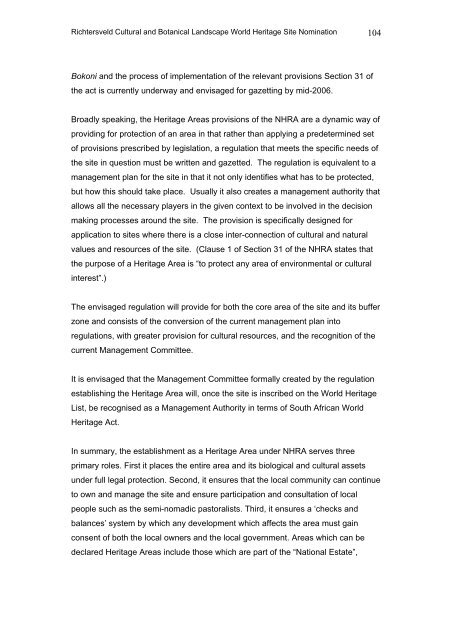the richtersveld cultural and botanical landscape - SAHRA
the richtersveld cultural and botanical landscape - SAHRA
the richtersveld cultural and botanical landscape - SAHRA
You also want an ePaper? Increase the reach of your titles
YUMPU automatically turns print PDFs into web optimized ePapers that Google loves.
Richtersveld Cultural <strong>and</strong> Botanical L<strong>and</strong>scape World Heritage Site Nomination 104<br />
Bokoni <strong>and</strong> <strong>the</strong> process of implementation of <strong>the</strong> relevant provisions Section 31 of<br />
<strong>the</strong> act is currently underway <strong>and</strong> envisaged for gazetting by mid-2006.<br />
Broadly speaking, <strong>the</strong> Heritage Areas provisions of <strong>the</strong> NHRA are a dynamic way of<br />
providing for protection of an area in that ra<strong>the</strong>r than applying a predetermined set<br />
of provisions prescribed by legislation, a regulation that meets <strong>the</strong> specific needs of<br />
<strong>the</strong> site in question must be written <strong>and</strong> gazetted. The regulation is equivalent to a<br />
management plan for <strong>the</strong> site in that it not only identifies what has to be protected,<br />
but how this should take place. Usually it also creates a management authority that<br />
allows all <strong>the</strong> necessary players in <strong>the</strong> given context to be involved in <strong>the</strong> decision<br />
making processes around <strong>the</strong> site. The provision is specifically designed for<br />
application to sites where <strong>the</strong>re is a close inter-connection of <strong>cultural</strong> <strong>and</strong> natural<br />
values <strong>and</strong> resources of <strong>the</strong> site. (Clause 1 of Section 31 of <strong>the</strong> NHRA states that<br />
<strong>the</strong> purpose of a Heritage Area is “to protect any area of environmental or <strong>cultural</strong><br />
interest”.)<br />
The envisaged regulation will provide for both <strong>the</strong> core area of <strong>the</strong> site <strong>and</strong> its buffer<br />
zone <strong>and</strong> consists of <strong>the</strong> conversion of <strong>the</strong> current management plan into<br />
regulations, with greater provision for <strong>cultural</strong> resources, <strong>and</strong> <strong>the</strong> recognition of <strong>the</strong><br />
current Management Committee.<br />
It is envisaged that <strong>the</strong> Management Committee formally created by <strong>the</strong> regulation<br />
establishing <strong>the</strong> Heritage Area will, once <strong>the</strong> site is inscribed on <strong>the</strong> World Heritage<br />
List, be recognised as a Management Authority in terms of South African World<br />
Heritage Act.<br />
In summary, <strong>the</strong> establishment as a Heritage Area under NHRA serves three<br />
primary roles. First it places <strong>the</strong> entire area <strong>and</strong> its biological <strong>and</strong> <strong>cultural</strong> assets<br />
under full legal protection. Second, it ensures that <strong>the</strong> local community can continue<br />
to own <strong>and</strong> manage <strong>the</strong> site <strong>and</strong> ensure participation <strong>and</strong> consultation of local<br />
people such as <strong>the</strong> semi-nomadic pastoralists. Third, it ensures a ‘checks <strong>and</strong><br />
balances’ system by which any development which affects <strong>the</strong> area must gain<br />
consent of both <strong>the</strong> local owners <strong>and</strong> <strong>the</strong> local government. Areas which can be<br />
declared Heritage Areas include those which are part of <strong>the</strong> “National Estate”,

















